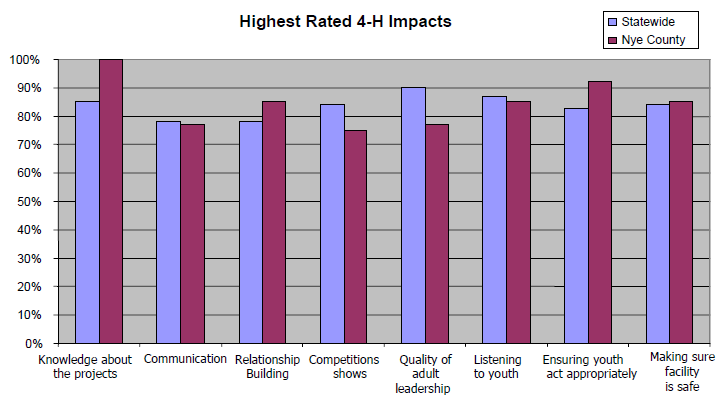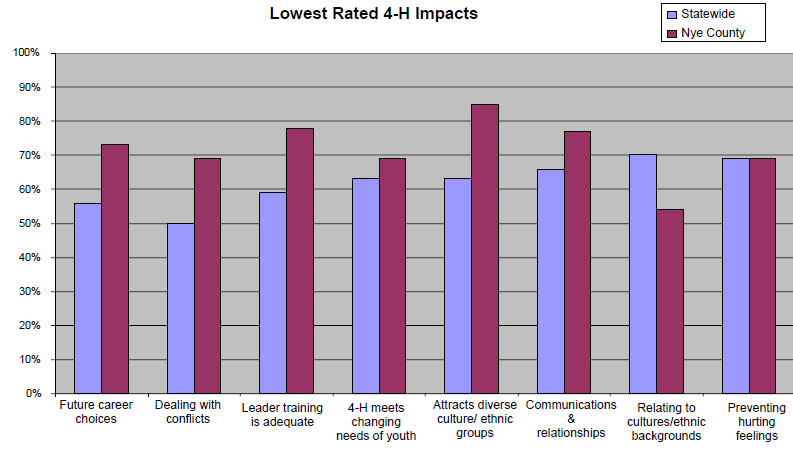Introduction
In continued efforts to assess 4-H program impacts, in 2003, University of Nevada Cooperative Extension surveyed all 4-H parents and leaders statewide. The results were sorted by county. Understanding impacts at the county level is important because 4-H programs in Nevada are managed at the county level. This fact sheet reports the impact assessment results statewide highlighting Northern Nye and Esmeralda counties. The purpose of this report is to inform 4-H parents, leaders and youth members how 4-H impacts their lives, and also assist 4-H professionals to develop an action plan to further strengthen Northern Nye-Esmeralda counties 4-H.
Designing and Conducting the Assessment
In designing a tool to assess 4-H program impacts, two models for youth development were used. The first model is based upon six outcomes to expect from successful youth development. These outcomes are confidence, competence, caring, connection, contributing, and character (Blyth, 2000).
Successful youth development helps children become: confident they can make a difference; competent through their ability, skills, and knowledge, and; able to work with people in a way that develops and promotes caring relationships. These youth connect beneficially with people and organizations, contribute their services to make a difference in their personal development as well as in their community, and demonstrate responsible and honest character, or a sense of whom they are.
Another model for youth development used to develop the assessment questions focuses on “core concepts” and provides a basis for successful youth development programs in Nevada (UNCE, 1993). Such programs produce youth who:
- learn and practice self-responsibility and social responsibility to feel accountable and in control of their lives;
- recognize when and how to make informed decisions and implement decisions to solve a problem or achieve goals;
- communicate effectively in both verbal and written form, to share thoughts and feelings which increase social competence, and;
- Obtain career and occupational information to help prepare for the world of work.
Questions developed for this assessment were based upon the six desired outcomes of positive youth development and Nevada’s “core concepts” for teaching life skills. Combining models resulted in nine questions to assess the effectiveness of 4-H in teaching youth (1) life skills, six questions to assess (2) social skills youth learn; six questions to measure the effectiveness of traditional 4-H (3) teaching tools and; four questions to assess efficacy of (4) program management goals.
In addition, eighteen questions were developed specifically to assess (5) parent and volunteer leader skills to teach youth, manage 4-H programs, and prevent negative and high-risk behavior among 4- H youth. These questions were based on skills established by the National Committee on Community Programs to Promote Youth Development (Eccles and Gootman, 2002). These questions were designed to assess the indirect impacts of Nevada 4-H on parents and volunteer leaders.
Participants in the assessment included all parents and adult volunteer 4-H leaders currently enrolled in Northern Nye and Esmeralda counties. These participants were selected based on the rationale that 4-H leaders and parents of 4-Hers have the most frequent opportunity to observe any changes that occur among youth participating in 4-H programs.
Each individual was mailed a two-page questionnaire with instructions, and a self-addressed and stamped return envelope. Also included was a cover letter that explained the purpose of the survey, ensured confidentiality to participants, and thanked them for their participation. Of the 103 survey recipients, 18 returned completed questionnaires resulting in a 17 percent response rate.
Statewide and County Impacts
On a scale of 1 to 5 with “1” being “very low” and “5” being “very high,” respondents were asked to circle the number that best indicates how effectively 4-H is developing youth and impacting adults involved. The results are presented by highest and lowest ratings in the figures. (For this report, 1 and 2 were combined to produce the lowest rated impacts 4 and 5 were combined to produce the highest rated impacts.) In the following figures, results for Northern Nye and Esmeralda counties are presented alongside statewide impacts for comparison purposes. Additionally, data are reported for the five areas of assessment described above.
The highest rated statewide impacts are illustrated in Figure 1 and county results are presented for comparison purposes. Individual questions are listed below each bar graph to specify and illustrate the percentage responses for each question. This data indicates that on four of the eight items, the county program exceeded statewide averages. This comparison is shown to identify the strengths for this county in comparison to the statewide program. Northern Nye and Esmeralda counties volunteers and parents identified their top rated impact as knowledge about the project. Figure 2 illustrates areas to target for improvement in Northern Nye-Esmeralda counties 4-H. According to the assessment results, the lowest rated impact for Northern Nye and Esmeralda counties in comparison to statewide averages is relating to cultures/ethnic backgrounds.
Finally, Figure 3 illustrates the highest rated county impacts that differ from the statewide averages. This figure is included because the local program results indicated that several of the local top-rated strengths are not the same as the statewide program as shown in figure 1. For example, Northern Nye- Esmeralda counties rated self-confidence around others (100%) than statewide (84%). In contrast, Northern Nye-Esmeralda counties rated the skill of trusting others higher (85%) than statewide (72%). Other examples of higher rated skills are newsletters, having high expectations of youth, and managing conflict between youth as skills and abilities higher than the rest of the state as shown in Figure 3. These examples illustrate the need to compare and contrast county results with statewide results.
In addition to the data shown in Figures 1,2, and 3, additional data analysis (Smith & Singletary, 2004) was conducted to identify highest and lowest rated county impacts in five different areas: (1) life skills, (2) social skills, (3) teaching tools (4) program management goals, and (5) parents and volunteer leader skills. The data indicates that the overall top life skills Northern Nye-Esmeralda counties youth learn are: Knowledge about their projects and achieving greater self-confidence around others. The highest rated social skill youth learn is: Trusting others and being trustworthy. In terms of teaching tools, the highest rated impacts in Northern Nye-Esmeralda counties are: Newsletters and the quality of adult leadership. The highest rated program management skill is ensuring youth act appropriately. For 4-H parents and volunteer leaders, the highest rated parent and leader teaching skills are: Letting youth know I have high expectation of them, and making sure the facility is safe, and managing conflicts.
Finally, the survey showed the lowest rated social skill youth learn is: dealing with conflicts. For 4-H parents and volunteer leaders, the lowest rated teaching tool is: leader training is adequate. In terms of 4-H teaching and program management goals, the lowest rated impacts in Northern Nye-Esmeralda counties are attracting diverse ethnic groups. The lowest rated parent and leader teaching skill is: providing activities designed to help youth learn social skills such as communication and relationship building. Program management skill is relating well to youth from different cultures and backgrounds; and the prevention skill is: keeping youth from hurting each other’s feelings.
Figure 1. Highest Rated Impacts

Data From Figure 1
Figure 2. Lowest Rated 4-H Impacts

Data From Figure 2
Figure 3. Highest County Impacts Different from State

Data From Figure 3
Developing an Action Plan to Strengthen Northern Nye-Esmeralda counties 4-H
To develop an action plan, Northern Nye-Esmeralda counties 4-H professionals combined assessment results with available demographic information. Table 1 illustrates these demographics for Northern Nye- Esmeralda Counties.
Table 1. N. Nye-Esmeralda counties Demographics
| Category |
Amount |
| Number of school-age children in Northern Nye-Esmeralda counties |
745 |
| Total number of 4-H youth in Northern Nye-Esmeralda counties |
222 |
*Ethnic distribution of children in Northern Nye-Esmeralda counties
(AI/AN) 3% (AS) 2% (H)14% (B) 3% (W) 79% White-(79%) |
White-(79%) |
Ethnic distribution of 4-H youth in Northern Nye-Esmeralda counties
(AI/AN) 4% (AS) 2% (H)12% (B) 2% (W) 79% |
White-(79%) |
| Median income of families in Northern Nye-Esmeralda counties |
$52,350 |
| Income distribution of 4-H families in Northern Nye-Esmeralda counties |
$50,000-$74,999 |
| Percent 4-H families in Northern Nye-Esmeralda counties earning below $25,000 annually |
9.1% |
| *Percent of families in Northern Nye-Esmeralda County earning below $25,000 |
33% |
*Denotes S. Nye Ethnic distribution of Public School county enrollment
*Denotes 2000 Nye County Census of Population and Housing Data |
The results of the survey indicate several items were rated highly by parents/volunteers in comparison to statewide averages. Additionally, highest and lowest rated survey items in each of the five areas surveyed were examined.
Northern Nye County 4-H will continue to build on these highly rated topics. Additionally, several topics were rated low by parents/volunteers. Northern Nye-Esmeralda counties 4-H will implement strategies to improve these topic areas.
Highly rated items: Overall, parent/volunteers rated youth knowledge and skills very high.
- Northern Nye-Esmeralda counties 4-H parents/volunteers rated the value of youth gaining knowledge about their projects and self-confidence around others at 100%. These two highly rated topics will continue to be a focus and priority for Northern Nye-Esmeralda counties 4-H.
- Letting youth know that we have high expectations of them, acquiring greater self-esteem and our county newsletters were the next highest rated at 92%.
- Relationship building was the highest rated social skills at 85%.
- The 4-H enrollment demographics match the ethnic distribution for the county.
Lowest Rated Items:
- Dealing with conflicts was the lowest rated social skill of youth assessed by parents/volunteers at 69%.
- Youth’s ability to relate to different cultures/ethnic backgrounds was a low rated item (54%).
- Competitions and shows were rated at 75% and the quality of adult leadership was 77%. These two items rated noticeably lower than the rest of the state.
Conclusions
Priorities in Northern Nye-Esmeralda County 4-H will be built upon the identified strengths and areas where we could improve. Project knowledge gain and self-confidence building are important strengths. Acquiring self-esteem and quality 4-H newsletters are also strengths.
Dealing with conflict is the lowest rated social skill and is a priority area of improvement for Northern Nye-Esmeralda County 4-H. As a team effort across the state and with our county volunteers, we will plan and develop training in areas such as conflict management. Our goal is to help the 4-H program participants more effectively deal with conflict.
An additional goal is to address the low rating regarding the quality of adult leadership. We will create a countywide team vision regarding the need for quality leadership. We will continue to recruit and build qualified youth volunteers, middle management volunteers, and youth. As we outline future programming, we need to develop an awareness of other cultures and recognize ethnic interests and backgrounds. Thus provide youth with opportunities to be involved in learning about different cultures and ethnic groups.
These action plans will serve as guidelines for strengthening 4-H in a positive, objective manner, and to continue to generate new ways in which 4-H can make the best better.
References
- Blyth, D. 2000. “Extension’s Roles in Community Youth Development for the 21st Century,” The Center. Communication and Educational Technology Services, University of Minnesota Extension Service.
- Singletary, L. and M. Smith. 2004. Nevada 4-H Statewide Impact Assessment. Extension Bulletin. EB-04-01. Reno, NV: University of Nevada Cooperative Extension.


